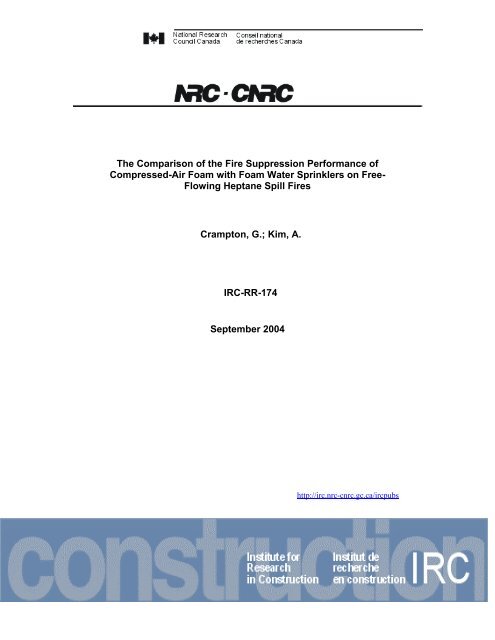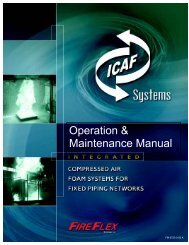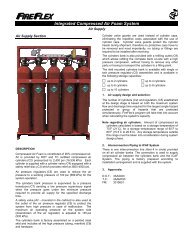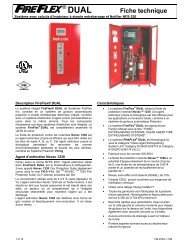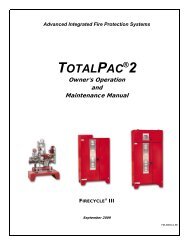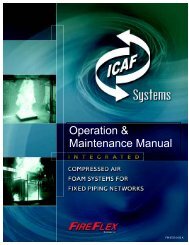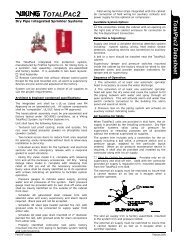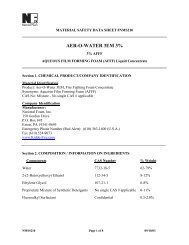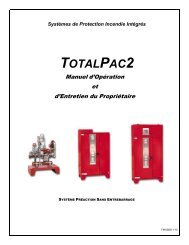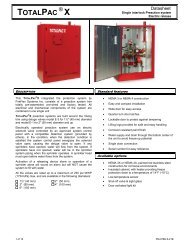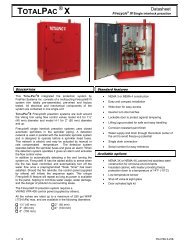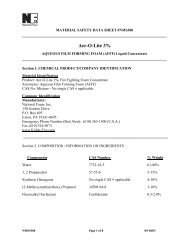Performance of Compressed-Air Foam with Foam Water Sprinklers ...
Performance of Compressed-Air Foam with Foam Water Sprinklers ...
Performance of Compressed-Air Foam with Foam Water Sprinklers ...
Create successful ePaper yourself
Turn your PDF publications into a flip-book with our unique Google optimized e-Paper software.
The Comparison <strong>of</strong> the Fire Suppression <strong>Performance</strong> <strong>of</strong><strong>Compressed</strong>-<strong>Air</strong> <strong>Foam</strong> <strong>with</strong> <strong>Foam</strong> <strong>Water</strong> <strong>Sprinklers</strong> on Free-Flowing Heptane Spill FiresCrampton, G.; Kim, A.IRC-RR-174September 2004http://irc.nrc-cnrc.gc.ca/ircpubs
The Comparison <strong>of</strong> the Fire Suppression<strong>Performance</strong> <strong>of</strong> <strong>Compressed</strong>-<strong>Air</strong> <strong>Foam</strong><strong>with</strong> <strong>Foam</strong> <strong>Water</strong> <strong>Sprinklers</strong> on Free-Flowing Heptane Spill FiresResearch Report RR-174Date <strong>of</strong> Issue: September 2004Authors: George Crampton and Andrew KimPublished byInstitute for Research in ConstructionNational Research Council CanadaOttawa, CanadaK1A 0R6
Abstract<strong>Compressed</strong>-air foam (CAF) has been proven to be an effective fire suppressionmaterial for both class A and B fires. Comparison testing between CAF and standardfoam water sprinklers had been conducted previously to quantify the amount <strong>of</strong> foamrequired to extinguish a liquid fuel fire that was contained <strong>with</strong>in the bounds <strong>of</strong> a pan asspecified in the UL162 <strong>Foam</strong> Equipment and Liquid Concentrates standard. To dateonly a few smaller scale tests had been conducted using CAF to extinguish free flowingspill fires.This paper describes a series <strong>of</strong> full-scale Class B fire tests designed to compare CAF(<strong>Compressed</strong>-air <strong>Foam</strong>) and standard foam water sprinklers in extinguishing free flowingspill fires <strong>with</strong> and <strong>with</strong>out shielded areas.i
Table <strong>of</strong> ContentsAbstract………………………………………………………………………………….……iTable <strong>of</strong> Contents……………………………………………………………………….…..ii1.0 Introduction…………………………………………………………………….……11.1 Background………………………………………………………….……..11.2 Project Description…………………………………………………….…..12.0 Test Details…………………………………………………………………………22.1 Test Facility………………………………………………………………...22.2 <strong>Foam</strong> Delivery Systems…………………………………………………..32.3 Instrumentation…………………………………………………………….42.4 Test Procedure…………………………………………………………….53.0 Results………………………………………………………………………………53.1 Pan and Spill fire Comparison Tests……………………………………53.2 Unshielded Spill Fire Tests………………………………………………93.3 Shielded Spill Fire Tests………………………………………………..113.4 Milspec Shielded Fire Tests……….…………………………………...134.0 Conclusions……………………………………………………………………….155.0 Acknowledgements………………………………………………………………166.0 Bibliography………………………………………………………………………16ii
1.0 Introduction1.1 BackgroundPan fires are an excellent, reproducible way to evaluate and compare extinguishingsystems. Pans are used in many standard test methods and CAF has proven to havesuperior performance when compared to conventional foam water sprinkler systems inthese tests. Concerns in the industry have arisen about CAF’s ability to extinguish amore realistic fire scenario involving free-flowing spill fires. These fires are especiallydifficult to extinguish when they are shielded from the direct delivery <strong>of</strong> foam from thenozzle. This would be the case in hangers where large floor areas would be shielded byaircraft or other service vehicles.In order to address these concerns a series <strong>of</strong> spill fire tests were designed to evaluatethe performance <strong>of</strong> CAF on increasing spill fire sizes <strong>with</strong> and <strong>with</strong>out shielding. Tw<strong>of</strong>oam water sprinkler tests would also be conducted for the purpose <strong>of</strong> comparison.1.2 Project DescriptionThis report describes a series <strong>of</strong> 9 full-scale Class B fire tests designed to compare CAFand foam water sprinklers in extinguishing free-flowing heptane pool fires, increasing insize from 4.65 m 2 to 14 m 2 on a 6m by 6m flat concrete slab. The flow <strong>of</strong> fuel would becontrolled by a valve removed from the fire location and the fuel would be delivered tothe slab through a 25.4 mm diameter steel pipe. In addition to visual observations,radiant heat flux was also measured at a point 1.83 m from the edge <strong>of</strong> the fuelboundary and 1.5 m <strong>of</strong>f the ground. This would allow a comparison to be made <strong>with</strong> theprevious pan fire tests <strong>of</strong> the same size. The fuel drum was positioned on weigh scalesto monitor the flow <strong>of</strong> fuel during the tests.The first 2 tests would confine the spill to a 4.65 m 2 area using a bead <strong>of</strong> silicon caulking.Due to the uneven characteristics <strong>of</strong> the slab this was necessary to achieve thecomparison data. Tests 3 to 9 would have no confinement and the fuel would beallowed to flow freely over the slab. Tests 6 to 9 would have a 1 m by 1 m tablepositioned over a fuelling outlet preventing the foam from landing directly on the fuelsurface under the table. To extinguish this scenario, the foam must be fluid enough to1
flow under the table. Tests 8 and 9 would use the standard foam sprinklers in place <strong>of</strong>the CAF system.2.0 Test Details2.1 Test FacilityThe tests were conducted indoors at the Fire Research Program’s Fire Laboratory wherethe burn hall measures 55 m long by 30 m wide by 12 m high. At the time <strong>of</strong> theexperiments the ambient temperature was between 20 and 25 degrees Celsius. The36 m 2 test area was formed level using fibre reinforced concrete (see figure 1).Concentric circles were painted on the slab at 2.44 m, 3.44 m, 4.21, and 4.87 m indiameter. Each circle represents an increase in area and fire size by factors <strong>of</strong> 1, 2, 3,and 4 respectively.A grid <strong>of</strong> 4 CAF nozzles or sprinkler heads were positioned 10.7 m above the slab at a3.73 m by 3.73 m spacing. Extinguishment data was taken using a 2 w/cm 2 heat fluxmeter and Solartron data acquisition system. The heptane fuel was delivered through apreset valve from a 205 litre drum mounted on weigh scales shown in the area on the leftin figure 1.Figure 1. Fire test facility2
2.2 <strong>Foam</strong> Delivery SystemsThe foam delivery system was supplied by FireFlex Systems Inc. and is shown in figure 2.This system mixes the correct amount <strong>of</strong> water, air and foam concentrate so that CAF canbe formed in the delivery piping.Figure 2. <strong>Foam</strong> delivery apparatus.The CAF is then distributed over the target area through 4 CAF rotary nozzles shown infigure 3. When the foam water sprinkler system is installed the same piping is used andthe foam water is delivered at the same outlet locations. The delivered density for theCAF system is 1.63 l/min/m 2 while the foam water sprinkler system delivers 6.5 l/min/m 2 .The total water flow for the 4 CAF nozzles is 90 l/min and the flow for the foam watersprinkler system is 360 l/min. The expansion <strong>of</strong> the CAF system is 10:1 <strong>with</strong> a drain time<strong>of</strong> 5 min 20 seconds and a solution concentration <strong>of</strong> 2% Class B foam for tests 1 to 6and 2% milSpec Class B for test 7. The foam water sprinkler system had a 3:13
expansion <strong>with</strong> a drain time < 1 min and a solution concentration <strong>of</strong> 3% Class B foam fortest 8 and 3% milSpec Class B for test 9.Figure 3. CAF Delivery Nozzle2.3 InstrumentationThe solution flow was monitored using a calibrated Krohne model Ec<strong>of</strong>lux 1010 Magneticflow-meter and the airflow was measured using a Brooks Model 1112A09G3B1Arotometer. Pressures were measured using calibrated pressure gauges, and foamexpansions and drain times were determined by weight using a Mettler PC4400calibrated balance. Radiant heat flux measurements were taken using a Medtherm Heatflux transducer Model 64-02-14 Serial # 57496 and recorded on a Solartron model 3595IMP data acquisition system. The tests were recorded on a the Sony Model DCR-TRV340, 8 mm digital video tape and still photos were taken using a Sony Model DSC-F707 digital camera..4
2.4 Test ProcedureThe tests were initiated by pre-spilling the fuel for a period <strong>of</strong> 45 seconds. This wasdone using a pre-set valve for the flow rate and a separate valve to turn the flow on or<strong>of</strong>f. The fuel forms a pool that extends to the boundary <strong>of</strong> the fire area in the 45 secondpre-fill time. This is true for all flow rates and fire sizes. The data system is thenactivated and the fire is ignited from the edge <strong>with</strong> a propane torch. At 15 seconds fromignition the foam is applied and the test continues until the fire is completelyextinguished or 5 minutes has elapsed. The first 3 tests were fuelled from a single pointin the centre <strong>of</strong> the slab. Due to slight unevenness in the slab surface it was decided todeliver the fuel from 4 outlets to cover the area <strong>of</strong> interest more accurately. This 4 outletfuel delivery system was used for the remaining 6 tests. A table was added for tests 6-9to provide a shielded area and this set up is shown in figure 4.Figure 4. Shielded test set-up3.0 Results3.1 Pan and Spill fire Comparison TestsTests 1 and 2 were spill fire tests confined to 2.44 m diameter <strong>with</strong> a shallow bead <strong>of</strong>silicon caulking. A radiant heat flux meter was positioned at a point 1.83 m from theedge <strong>of</strong> the fuel boundary and 1.5 m <strong>of</strong>f the ground. It was determined from spilling5
heptane onto a water base that 8 l/min would be required to sustain a 2.44 m diameterfire. Since the surface <strong>of</strong> the concrete was rougher than water it was decided to spill 11l/min. Based on the heat <strong>of</strong> combustion for heptane this translates to a 6 megawatt fire.It was observed during the test that the fire did extend beyond the caulking boundarybefore the foam was applied. This indicated that the estimate for the flow rate <strong>of</strong> the spillwas correct at around 8 l/min. The pan fire <strong>of</strong> the same size consumes 21.3 l/min andhas a heat output <strong>of</strong> 11.5 megawatts. Figure 5 compares the radiant heat flux from thepan and the spill fire and clearly shows that pan fire has a 67% higher heat flux 15seconds after ignition, at the point when the foam application begins.30<strong>Foam</strong> Applied@15 s after ignitionPan fireHeat Flux (kw/m2)2010Spill fire00 10 20 30 40 50 60 70 80Time (seconds)Figure 5. Radiant heat Flux from a 2.44 m diameter pan and spill fireTest 3 used the same fuel flow rate (11l/min) as test 1 and 2 except the caulking wasremoved and the area was no longer confined to 2.44 m in diameter. Figure 6 showsthe radiant heat flux <strong>of</strong> the confined spill compared to the unconfined spill. The fact thatthe unconfined spill fire is larger confirms that 11 l/min is excessive for the 2.44 mdiameter fire and the estimated 8 l/min is the required flow rate to sustain the 2.44 m fire.Test 4 used the same fuel flow rate (11 l/min) but delivered the fuel from 4 points instead<strong>of</strong> 1 central point. The more uniform distribution <strong>of</strong> fuel is represented in the higher heatflux shown in figure 6.6
30<strong>Foam</strong> Applied@15 s after ignitionUnconfined spill fire<strong>with</strong> 4 oultletsHeat Flux (kw/m2)2010Unconfined spill firesingle outletSpill fire confinedby caulking bead00 10 20 30 40 50 60 70 80Time (seconds)Figure 6. Confined and unconfined free-flowing spill fire.This comparison data is supported by the section on Liquid Fuel Fires by Gottuk andWhite in the SFPE Handbook <strong>of</strong> Fire Protection Engineering.Extinguishment times for tests 1 to 4 and the pan fires <strong>of</strong> the same size are all between45 and 60 seconds <strong>of</strong> foam application. The results <strong>of</strong> all the tests are shown in Table1.7
Table 1. Spill Fire Test ResultsTest #<strong>Foam</strong> TypeTest DescriptionHeptane FuelFlow rateShielded FireSolution Flow;l/min<strong>Foam</strong>Distribution;litres/min/m2Fire SizeMwExtinguishmenttime; min:s99% 100%1 CAF B, 2% 11 l/ min no (confined to 4.65m2) 90 1.63 4.65m2) 90 1.63 6 1:05 1:285 CAF B, 2% 22.5 l/ min yes ( unconfined >13m2) 90 1.63 11.5 1:26 1:386 CAF B, 2% 22.5 l/ min yes ( unconfined >13m2) 90 1.63 11.5 1:55 4:587 CAF Milspec B, 2% 22.5 l/ min yes ( unconfined >13m2) 90 1.63 11.5 1:45 4:208 FWS ClassB, 3% 22.5 l/ min yes ( unconfined >13m2) 360 6.5 11.5 1:30 not ext.9 FWS Milspec B, 3% 22.5 l/ min yes ( unconfined >13m2) 360 6.5 11.5 2:00 not ext.8
3.2 Unshielded Spill Fire TestsTests 1 to 4 were unshielded spill fire tests to establish comparisons <strong>with</strong> pan fires <strong>of</strong> thesame size. The 8 l/min flow rate required for the 4.65 m 2 fire was increased to 22.5 l/minand produced a fire area over 13 m 2 for all the remaining tests.Test 5 was an unconfined and unshielded fire <strong>with</strong> a 22.5 l/min fuel flow rate. The heatflux shown in figure 7 is significantly higher than the smaller fires from tests 1 to 4 andthe time required to extinguish the fire to the fuelling outlets is approximately 30 secondslonger.50<strong>Foam</strong> Applied@15 s after ignitionHeat Flux (kw/m2)403020all but fuel point extinguished@ 86 s <strong>of</strong> foam application100 % Extinguished@ 98 s <strong>of</strong> foam application1000 10 20 30 40 50 60 70 80 90 100 110 120Time (seconds)Figure 7. Heat flux from the 13 m 2 fire size (Test 5)Figure 8 shows the photo extinguishing sequence from the smaller fire <strong>of</strong> test 3 and thelarger fire from test 5. The time to completely extinguish the larger fire is 16 secondslonger than the smaller fire <strong>of</strong> test 3. The photo frames are at 30 second intervals fromfoam application on the top to the second last frame from the bottom. The last frameshows the exact extinguishment time.9
Test 5 (Fire 13 m 2 ) Test 3 (Fire 4.65 m 2 )<strong>Foam</strong> Activation30 seconds60 seconds90 seconds 82 seconds98 seconds10Figure 8. Photo Sequence for test 5 and test 3
3.3 Shielded Spill Fire TestsTests 6 to 9 were shielded tests incorporating a 1m by 1m by 0.8 m high steel tablepositioned over one <strong>of</strong> the four fuel outlets. The area <strong>of</strong> shielding is shown in figure 9.Figure 9. Shielded area under tableIn order to extinguish the fire under the table the foam must build up and flow. This ismade more difficult by the dynamics <strong>of</strong> the flowing stream <strong>of</strong> fuel exiting the outlet.Under these conditions the CAF system in test 6 was able to confine the fire to theshielded area in under 90 seconds and choke the fire to a candle size in under 2minutes. The fire continued to candle until the outlet was buried by the CAF blanket andwas extinguished at 4 min 58 s. The foam water sprinklers (test 8) had a faster knockdown due to its greater flow characteristics but once a water layer formed on the slab thefuel was floated on the surface and the fire increased in size and spread, flowing flamesat times <strong>of</strong>f the slab. At the end <strong>of</strong> 5 minutes <strong>of</strong> foam water application the fire wasstable and not reducing in size. Figure 10 compares test 6 (90 l/min CAF at 2% ClassB concentration) <strong>with</strong> the <strong>Foam</strong> water sprinkler test 8 (360 l/min at 3% concentration).11
Test 6 (CAF)Test 8 (FW <strong>Sprinklers</strong>)<strong>Foam</strong>ActivationContinued fromAdjacent columnFigure 10. Extinguishment sequences at 30 s intervals12
3.4 Milspec Shielded Fire TestsTest 7 and test 9 had the same conditions as tests 6 and 8 except the regular Class Bfoam was replaced <strong>with</strong> milspec Class B foam. The milspec foam performed better thanthe standard foam in both the CAF and foam water sprinkler tests. The greatestdifference was the initial knock down time being 20 to 30 seconds faster <strong>with</strong> the milspecfoam. In the case <strong>of</strong> the foam water sprinklers it also controlled the fire better than thestandard foam keeping the flare-ups suppressed and not allowing fire to spread as easilyafter several minutes <strong>of</strong> application. At the end <strong>of</strong> the 5 minute application time it wasunable to completely extinguish the fire in the foam water sprinkler test but the fire wassmall and confined to the shielded area at the fuel outlet. The CAF test was able tocompletely bury the outlet and extinguish the fire in 4 minutes and 20 seconds. Figure11 shows the side-by-side photo extinguishment sequences for the milspec foam tests.13
Test 7 (CAF)Test 9 (FW <strong>Sprinklers</strong>)<strong>Foam</strong>ActivationContinued fromAdjacent columnFigure 11. Extinguishment sequences at 30 s intervals14
4.0 ConclusionsThe CAF system was able to suppress a 2.44 m diameter free-flowing spill fire as fast asthe 2.44 m diameter pan fire. It took longer to completely extinguish the spill fire due tothe difficulty in covering the fuel flowing from the outlet. When the fire was increased to3 times the area and heat release, the CAF system took less than 30 seconds longer tosuppress the fire and only 16 seconds longer to completely extinguish it. The foamwater sprinkler system was able to suppress the spill fire faster than the pan fire due tothe addition <strong>of</strong> the fast flowing foam water on the slab combining <strong>with</strong> the foam waterlanding on the fuel surface directly. The pan fire must be extinguished by the lattermethod only. After only 30 seconds <strong>of</strong> discharge the depth <strong>of</strong> foam water on the slabwas enough to reduce the benefit <strong>of</strong> the flowing foam water and allow the fuel to ride ontop <strong>with</strong>out a great deal <strong>of</strong> interaction between the two. In the standard Class B foamtests this gave the fire the opportunity to actually grow in size and free flow <strong>of</strong>f <strong>of</strong> theslab. This situation is not desirable since the fire could be floated out <strong>of</strong> the protectedzone or be allowed to burn back quickly should the system run out <strong>of</strong> concentrate orwater. After the sprinkler test was over there was no fuel left on the slab to clean up. All<strong>of</strong> the fuel was deposited into the trenched area which had filled and overflowed. Incontrast to this the CAF system was able to build up and completely extinguish the fire.After 30 seconds the CAF had build up on the slab and began to flow. The flow <strong>of</strong> CAFunlike the flow <strong>of</strong> foam water was able to cover the surface <strong>of</strong> the fuel and not flow underit. At the end <strong>of</strong> the tests most <strong>of</strong> the fuel remained on the slab in the protected zoneand the less dense CAF had covered the fuel surface and overflowed the slab leavingthe fuel behind. This could be extremely beneficial in fuel storage areas protected bydykes where the fuel can be contained <strong>with</strong>in the dyke and the CAF can overflow <strong>with</strong>outthe danger <strong>of</strong> spreading the fuel.The CAF system was able to suppress the large free-flowing spill fires using 25% <strong>of</strong> thewater flow and a factor <strong>of</strong> 6 less concentrate when compared to the foam water sprinklersystem. It was able to extinguish the fires completely by covering the fuel outlet whilethe foam water sprinkler system could not. CAF was able to flow under the shieldedarea after 30 seconds <strong>of</strong> discharge. Visibility was well maintained throughout the CAFtests <strong>with</strong> very low steam production.15
5.0 AcknowledgementsThe authors wish to thank Jean-Pierre Asselin and the staff <strong>of</strong> FireFlex Systems Inc.,Michael Ryan and the staff <strong>of</strong> the Fire Research Program for their assistance andcontributions to this test series.6.0 Bibliography1. Crampton, G.P., et al. A new Fire Suppression Technology, NFPA Journal, Vol.93, No. 4, National Fire Protection Association, Quincy, MA 1999.2. Kim, A.K. and Dlugorski, B.Z., An Effective Fixed <strong>Foam</strong> System using<strong>Compressed</strong> <strong>Air</strong>, Proceedings <strong>of</strong> the International Conference on Fire Researchand Engineering, Society <strong>of</strong> Fire Protection Engineers, Orlando, FL, 1995.3. CAN/ULC-S560-98 Standard for Category 3 Aqueous Film-Forming <strong>Foam</strong>(AFFF) Liquid Concentrates.4. UL 162, Standard for <strong>Foam</strong> Equipment and Liquid Concentrates5. NFPA 412 – Standard for Evaluating <strong>Air</strong>craft Rescue and Fire Fighting <strong>Foam</strong>Equipment, National Fire Protection Association, Quincy, MA 1998.16


